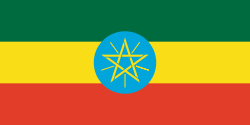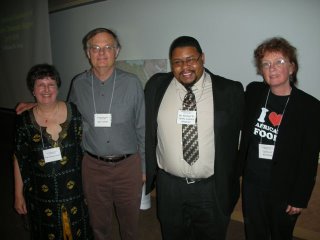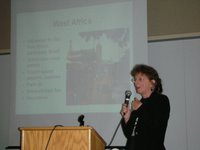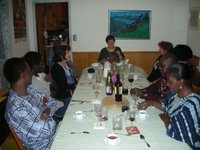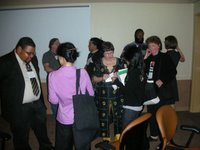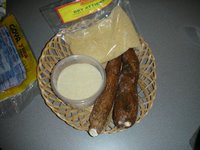Step-by-step American-style Injera, Parts 1 and 2
Here are parts 1 and 2 of the video I promised of our injera cooking lesson. As I mention in the introduction, we used 4 cups of all-purpose wheat flour with 1 cup of teff flour (I can buy teff in the organic/health section of our local supermarkets, or you could likely find it in a health foods market or African market catering to East Africans). Laura Litwiller suggests, however, using 2 cups of teff and 3 cups of all-purpose flour.
Day 1 (Wed): Assuming you have some starter already, you prepare the injera batter. (Note: Laura provided us with some of her starter, but she explains you can make your own using approximately a tablespoon of yeast, a half cup of teff and a half cup of white all-purpose flour, and warm water. Mix it together and let it ferment for a day or two before using it the first time). Starter is just a cup or so of batter you save each time you make the injera and set aside in a covered jar in the refrigerator. We let our starter come to room temperature before using it.
1. Begin by mixing the all purpose wheat flour (about 3 cups) and the teff flour (about 2 cups) with a wire wisk. The flour should be at room temperature, and we did not sift before adding it to a non-corosive lidded container (we used an enameled pot). Laura repeatedly reminded us "it's not an exact science."
2. Drain and discard the water off the top of the stored batter (leet). Using a spoon or spatula, scrape the thick batter remaining into a large bowl (this will be much less than the cup or so you started with). Heat 5 cups of water slightly (barely tepid) and pour a little of the water into the jar that contained the starter, shaking it to remove all of the starter batter. Add that to the bowl with the along with the rest of the water, and blend with the wisk.
3. Add about a quarter or a third of the water to the pot containing the flours, stir with the wisk, and repeat until all the water is used, stirring well after each addition, and making sure to blend all the flour in the bottom corners of the pot.
4. Cover the pot, and set it in a warm place free of drafts for two days to ferment. We had cool weather in our kitchen last week, so I kept my pot on the stovetop with the overhead stove light on, and by the end of the first day the fermentation process had still hardly begun. I cooked pizza that night and the heat from my oven must have warmed the stovetop slightly because after that the dough began fermenting in ernest. However, according to Laura, the normal procedure is for the dough to rise up and then separate into water on top and thick batter below. That didn't really happen very much, and we had very little water to remove when we were ready to make the injera. Laura said that was fine, too. Resist lifting the lid too often to see how the process is progressing, and certainly never stir it.
On Day 3 (Friday), 2 days later, we made the injera, along with 2 Ethiopian stews. I'll post those videos and recipes next.
Incidentally, I haven't forgotten that I still have 3 questions on African cooking to answer: the next one is the one about why African restaurants do not seem to be as popular or prevalent as other restaurants, from Asian to Chinese or Italian. I'll get back to those (and to the recipes from the regional Ghanaian cookbook) as soon as I catch up a little.
Labels: Ethiopian food, injera, leet, litwiller, Shields, teff
